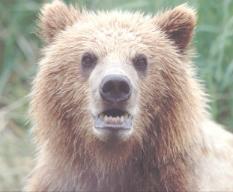
Rocky Spencer loved animals and in his capacity as the large carnivore specialist for the Washington Department of Fish and Wildlife he had an opportunity to contribute to the conservation of these magnificent animals. His career came to an end September 8th in a tragic helicopter accident during an effort to relocate bighorn sheep from private property to a Pullman research facility for Washington State University.
Rocky's funeral was well attended by close to a thousand people. There was much said about his skill as a biologist, his dedication to wildlife and his long service to the state. He never got hardened by repeated work with wildlife and treated each animal with care and dignity. He made efforts to involve the public in his work and gave many the opportunity to see and touch wild animals that they never would have had the chance to in their lives. A young man stood up and said because of one of these trips with Rocky he was inspired to go to college and is pursuing a career as a wildlife biologist. I know many others present have felt the same inspiration to be better wildlife stewards if nothing else because of these unique experiences.
He was also a natural teacher, and spoke often with youth and adults about wildlife, especially large carnivores, cougars and bears. Through talks at schools and interviews with the media, he reached a wide audience.
Rocky initiated many programs within the Department of Fish and Wildlife. Foremost, Rocky pioneered the use of dogs in wildlife management with his Karelian bear dog Mishka. He is credited with starting their cougar research program, finding the first nesting loons in the state and , ironically, starting the helicopter program. He worked at WDFW for almost 30 years. There was a huge turnout of current and former employees to honor him.

Chris Morgan, director of GBOP, who knew Rocky well had this to say "This picture was taken while I was out doing bear capture work with him in 1998 in the Tolt River watershed east of Seattle. He's taking an anesthetized black bear back to it's capture location for release.
A warm heart, a caring smile, an easy laugh, and a love for life. There are few people around as special as Rocky. So many people were drawn in by his infectious ways. For me it was ten years ago when I arrived from distant shores to take up bear work in Washington. From moment one Rocky was never anything but kind, open, and giving, and I loved working with him and knowing him as a friend. Words can't do it justice. He will be so missed - professionally and personally - bears and cougars never had a better, more passionate, more sincere advocate. My warm wishes and condolences go to the many, many people whose lives he touched, and especially his family."
Rocky was an avid fisherman, treasure hunt diver, and marathon runner. We will all remember him as a jokester, with an endless sense of humor, a Cheshire grin and that certain twinkle in his eye.
To me he was a friend for 20 years and a mentor in my work as a biologist. We worked together on loon, cougar and elk projects, and most recently on joint bear presentations. He inspires me to continue this work with bears, to honor the fortune I have to be able to work with wildlife and to honor the value of educating people about wildlife and the environment. It was remarkable how many people were touched by his education efforts. They are far reaching, and enduring. I think we should all take what we do with more pride and value, and know that it is important and worthwhile.
You can
click here to read what other people wrote about Rocky.
Julie L. (Hayes) Hopkins, GBOP Field Coordinator
Marine and Wildlife Biologist
Threatened and Endangered Species Specialist







